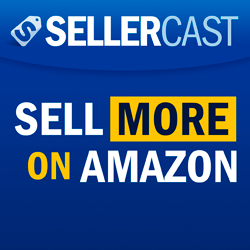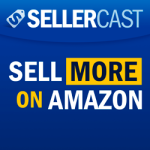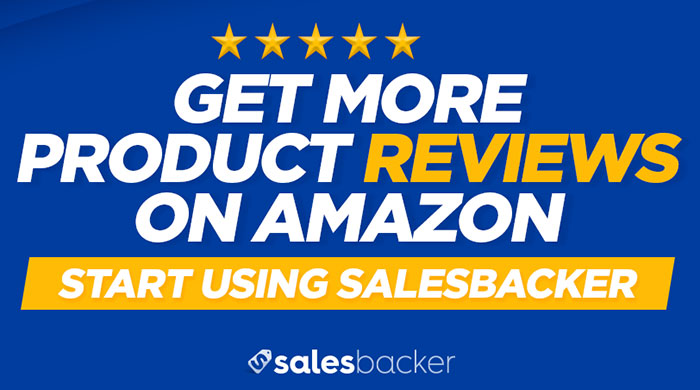 Direct podcast MP3 download link
Direct podcast MP3 download link
Like the show? Get new episodes on iTunes or Stitcher
Zach has been selling on Amazon for less than a year, but he's been building his business product by product, all while working an incredibly demanding high pressure tech sales job.
If you have a demanding job Zach covers the steps he's been using to grow his business on the side while continually reinvesting for growth.
Want to ask a question?
Get involved and ask a question about selling on Amazon and Chris may answer your question live on a future episode of Sellercast. Also, if you think you'd be a good guest for the Sellercast podcast feel free to tell us more about you and your company here.
Need more product reviews?
If you'd like to get more reviews for your products on Amazon check out Salesbacker.
Podcast Transcript
Intro: Hello everyone. It’s Chris Guthrie here, host of Sellercast. And in today’s episode, I speak with my friend Zach. Zach is a great inspiration because if you’re building your ecommerce business on the side and moonlighting in a sense to try and grow that business like he’s doing, then I think that you’re going to be able to relate to this very well because he talks about what he’s doing to help grow his business. And I’m sure you are going to enjoy this episode. So let’s start the recording. And here we go.
=====
Chris Guthrie: Zach, welcome to the show.
Zach: Hey, Chris. It’s an honor and a pleasure to joining on.
Chris Guthrie: Yeah. I’ve known you for quite a while. We had the fortune of being able to meet in person at an event a while back and so it’s great to have you on the podcast as well. A lot of our guests have been the people that I have met personally and so it’s great that you are able to be here as well.
I like to just get into a little bit of your history in terms of where you are at with your ecommerce business. So you can start off with that in terms of how you have been selling on Amazon for.
Zach: So I’ve been selling on Amazon, I guess I officially went live on August 23rd of last year. I went through one of the courses, which kicked off. That was about 11 months ago. And into the course, it took me about two and a half to three months to get the product sourced and up on Amazon and I’ve been live ever since.
Chris Guthrie: That’s great. So what were you doing before you got into selling to Amazon? Do you have another business background or something else that you are doing in the past?
Zach: In terms of internet-type businesses, back in the late ’90s or early 2000s, I dabbled in some internet marketing type stuff. Then I guess maybe over the last couple of years, I was, on and off, dabbling into other things like building niche websites and that sort of thing.
And then one of these days, I had a light bulb moment. So just to backtrack, I have a full-time sales gig. I’m in software sales and that takes most of my time. There was a moment maybe about 18 months ago where I just figured I wanted to do something else to control my life, to have more freedom and be my own boss.
I started dabbling in niche sites and started listening to podcasts. I really had that light bulb moment when I listened to your interview with Brian Leyde about two years ago. I think I’m not the only one that listened to that podcast and had that light bulb moment too because I’ve heard some other folks mention that that was a critical point for them. So once I heard that podcast, I started digging in and found the course that I ended up signing up on and then the rest is history from there.
Chris Guthrie: That’s great. Yeah, I’ll link to it in the show notes for those who are interested in that episode. I can shout out to that and I’ll put that link at the end here.
Are you still working your day job now? Or are you focused on Amazon full-time?
Zach: No. I’m still working full-time. I just had a face-to-face meeting early this morning and three phone calls. Between 8:00 and 5:00, I’m pretty much locked down on selling software and then I have about a couple of hours of family time before my nine year old goes to bed around 7:30. And then I typically try to plow away a couple of hours, strip away, every single night, a couple of hours towards my Amazon business. And I also probably put in about three or four on the weekends too.
So I’m definitely grinding away, working the software sales gig, but this is definitely my path. I see it as my path to cutting over and doing this full-time hopefully within the next 12 to 18 months or so.
Chris Guthrie: That’s great. We had a guest on a recent episode, episode 34. So it’s sellercast.com/34. He worked with a partner and they built up their business together and they are still just running it and they are only taking a small portion of their profits with the goal of they wouldn’t want to bother quitting their jobs until it was making a whole lot more than their day jobs are.
What’s your goal? Do you have a specific revenue targets you are trying to hit? Obviously, you are making sure that you are making profit from that revenue, but where are you at in terms of your sales and what you would like to be at to be able to leave your job?
Zach: Yeah, in terms of a revenue target, it’s less of a sales target. It’s more of “what am I bringing home?” sort of a target, what I was trying to hit. What I’m trying to do is look at it like this. So I have products and I want to be able to keep buying more inventory. So I’m slicing that away from any sort of income. Then I need to have X amount to make ends meet. Doing what I do, I’ve been doing these software sales for about 16 or 17 years, so I am at a certain salary level where I’m making really good money and I have all the benefits and things like that.
So we’re ready to be in order to keep our current lifestyle and maybe go over and above that a little bit. It probably needs to be in the range of around take-home, call it 25K to 30K. I’ll probably even start thinking about cutting over and doing those in little time. But I would want to be at that level and feel real confident about it for about six months at that sustained level. And I’m definitely trajecting in that direction.
To answer your other question on where I am today, I have three products live and I have four in production. Within the next 10 days, I’m going to pull the trigger on another three products. I’d look at say April. I think I did around 14,000 or so in sales working off of a profit margin of about 35% to 40%. So that’s where I am sitting today, but that’s starting to grow and grow every single month.
Chris Guthrie: That’s great. So then the three new products, I mean when you found your first suppliers, did you find it through a typical source like Alibaba or are you using some other type of a supplier?
Zach: I found it through Alibaba and when I found the supplier, it was for a product. When looking at their portfolio, I wanted to ensure that, with as many suppliers as I can—and obviously it’s not going to work out every single time—but at least the supplier that I enter in partnership agreements with, that they have other products that I’m going to be interested in down the road. And so the less I guess suppliers you are working with, I think that makes your life a little bit easier. So that’s what I had tried to do.
When I found this one supplier, they had four or five, maybe even eight different products that I could see rolling into my brands. But for some of these other products that are coming out, there are going to be two new suppliers. So surely, I’ll have about three suppliers that I am working with.
Chris Guthrie: That’s great. So three products you have right now, just to clarify, were those three separate individual suppliers?
Zach: Yeah. So I started off with one product and then I spun off and I had two variations of that product and I have a fourth variation of that product in production right now. And then the fifth product is coming from that same supplier as well. So I have five from one supplier and then two other products from another supplier. And then I’m either going to pull the trigger on two, maybe three products from this third supplier. So that’s the layout.
Chris Guthrie: Okay. I think especially people that are getting started, they only have one product. I really like the idea of just doing a variant as one of the first things you do simply because you can additional sales and in a lot of cases, just ask more choice for customers and they can help with the overall conversion rate on the listing.
Did you find that your sales spiked pretty well when you added your first variant? Or was it a little less subtle at first and then slowly charting down?
Zach: I think it was a little less subtle because when I rolled out products two and three, it was in February. It was February 23rd when those went live. And my type of product made, it went—to use a Chris Guthrie term—boo-yah!
So, between Halloween and basically December 22nd, I was doing 40,000 just with one product during the holidays. So I rolled out these two new products during the slow time. And Google Trends doesn’t lie. So for those listening here, try to do product research and look at Google Trends because that’s going to give you the scoop in terms of what the patterns are for these type of products.
And I went into it with eyes wide open. I saw the trend. I knew that there would be a dip. I didn’t think it was going to be as big of a dip as I saw in January and February, but once the weather started to warm up a little bit into mid-March, things have really started to snowball and it’s been going really well.
Chris Guthrie: That’s great. It’s a good point. I don’t think anyone else has mentioined Google Trends on the show before, but it’s a good tip.
I think obviously you can look at various tools. You can run your numbers. You can look at different products they are selling. Look at those. But even just doing a trend analysis to get a sense of just how much interest there is on a macro level is nice. I’m assuming that you saw a pretty big trend there, I guess.
Zach: Yeah. I mean it was literally it. So it was probably if you look at the trend chart starting in March, it started to slowly creep up until June and there is a little bit of a summer low. And then around mid-October, it just started to move up into the right and then come the middle of November, it just spiked up again in December and then that fell off for January and February.
So again, I knew what was going to happen or I thought was going to happen based upon Google Trends. That’s exactly how it played out.
Chris Guthrie: That’s great. Okay, so then with this posting that you have been doing, have you been trying to stockpile quite a bit of inventory, re-investing the vast majority of the money back in. I know that you are obviously going to be launching these other products soon. Because you have some of the most seasonal type products, do you feel you got caught with some extra inventory? Or how did you manage your inventory with those ones?
Zach: Yeah. Things are running so hot and heavy in Q4 that I was just trying to hoard stuff as fast as I could. And if I look at the three products that are live right now, I’d say, to use educational speak, two are A’s and the other one is probably a C. The one with C, I might have overshot a little bit in terms of just ordering too much. But eventually it’s starting to sell. It’s a product that I might not continue once it’s out.
But in terms of reinvestment or taking out profits and things like that, I haven’t taken out a single penny. I am reinvesting every single dime I can back into more inventories because one of the things that I learned in listening to all the podcasts and all the gurus is that you got to steal this business faster, the quicker you can or the more aggressively you are with reinvesting profits.
So I am taking zero off the table. My plan is to continue that throughout the rest of this year. So I will be about 16 months in before I even think about taking a dime off the table right now because I had some pretty lofty goals. I want to be up to around 10 to 12 products by around Halloween and then scale it up in 2017.
Chris Guthrie: I love it. That’s great. I think that’s a common trend that I’ve seen just from talking to guests on this show and also just in various conversations. People delay that gratification from taking the profits as far out as possible. And really you are able to scale a bunch faster. So that’s great.
Now, the actual launch process, I’m curious to see what you have done with your first product. And obviously it sounded like the first product did pretty well. And then the other products, you said you had two As and then one C.
What were you doing to launch your products? And what process were you doing to try and help make sure that you are successful? Are you doing anything off Amazon or are you primarily focused on everything on Amazon, Pay per Click, stuff like that?
Zach: Yeah. So the launch process starting there, I did a little bit different. I still have yet to use a review group. I fundamentally have problems with giving out free products to people, that only 70% of the time, are going to actually give you a review.
Chris Guthrie: Yeah.
Zach: I just have problems with that. And I look at listings and you just see. I was given this product at a discount in exchange for an honest. I just look at those products and I know I’m not the typical consumer. They’re just reading the reviews. They may not be getting down to the bottom. They are just looking at the stars.
But I just look at those products and I just shrug my shoulders like, “That just looks brutal.” If somebody is really reading these things and they keep seeing that over and over and over again, maybe they’ll have some pause. But I never use a review group.
When I selected a product, what I tried to do was not only find a product that resonated with me, that I could get behind and that it was something that I was excited about and something that the people around me, family and friends, that they be excited about it. So I looked at my friends and family as my launch group. And so when I launched, I basically leveraged the heck out of those people.
The way I did it was before I went live—probably about two weeks before, I think it was when my product wasn’t relevant—I basically reached out to everybody that I knew, letting them know about what my big goals were, about why I am spinning up this business to create a different lifestyle for me and my family. “Here’s what I’m looking to do. I am looking to start up this brand. Here is the first product.”
The product turned out to be one of those hot products. It was a product that I think now one of the courses is saying, “Don’t get into” at the time. It was something that I saw was starting. It was hard to figure out whether we’re at the beginning of the trend or the end. I think we are in the middle somewhere.
But I reached out to them and I was just laying it down like, “This is what I’m trying to do. This is my dream. Here is the product. If you are interested, let me know.”
Basically what I was doing was I was selling this product to them for about 40% off. I wasn’t doing anything like 75 or free or anything like that because I want to be making money back. I wanted to at least, at a minimum, cover my cost, which was then some. But I looked at my network, friends and family as my launch group and I was able to leverage them.
I have not needed to use a review group just yet and I think that strategy worked out well. Again, I’m in sales and so I’m not afraid to reach out to friends and family or anybody and position a product or something to them if there’s value in them and it can improve their lives. So that’s what I did and I literally had about 75 people ready to go once the lights went on and when they did, the first 48 hours, it just blew throughout. I think I started with 500 units and I think I blew through about 175 of those in about 48 hours.
And so things are starting to go, my BSR spiked. That was up there. And then the organic started to kick in. So that’s how I did my launch process. I kept things going with Pay per Click, Amazon, Pay per Click. So yeah, that’s how it went.
Chris Guthrie: Yeah, it’s interesting. From the time that you launched, I don’t think Amazon made this change. They specifically called out family members, telling them not to do leave reviews, but they don’t mention friends. I guess it’s a silver gray area.
I like the general approach of using them almost like your own cheerleading squad. Maybe that’s not the best analogy. But people that can be really excited about what you are trying to accomplish and then getting them on board to help you out, I like that.
Zach: Yeah. They’re extremely supportive for what I was trying to do. If you knew me like they know me, I think they understand that I have been doing this. I have been working for the “man” for a long time. I am at a certain age and a certain point in my life to where I’m tired of the BS. I’m tired of dealing with the politics. Even though I’m making great money and I live up here in Silicon Valley and it’s a great place to be, I’m over it and I am looking to do my own thing and they were onboard with that.
Chris Guthrie: I never lived in the area, but I can imagine that it’s somewhat different than pretty much any other places in the US.
Zach: It’s just outside of Seattle. So I think you get a little taste of it from where you are. But don’t get me wrong, high-tech is a great place to be. Doing what I do, it pays extremely well, but it really has come down to it’s not just about the paycheck. It’s about the lifestyle and not having to deal with the politics, reporting to myself and that thing.
Chris Guthrie: That’s great. So what else have you been doing? If you trace back to when you first got started and also as you have been going along here that’s been helping you to grow your business, what are some of the key traits that you found that have been able to help you succeed?
I think that launch strategy that you used was unique and that was nice. What are some other things that you have been doing to try and help ensure that each thing you do is another step towards your eventual goal?
Zach: One of the things I did, I think I mentioned it earlier, but when I was trying to figure out the path to go and get internet marketing or internet type of a business, there was another guy who I followed closely, Spencer Haws who I know you know. He was very much big into niche sites and things like that.
I think that the idea around niche sites and lots of contents and hitting the long tail and creating lots of articles that can drive people back to your website, that always resonated with me. And so when I got into Amazon, to get brand registered in Amazon, you have to just have your own website and things like that. That’s what I did. I spun up a basic site. But I also spun up about 25, 30 different contents, specific articles and that’s helping drive a decent amount of traffic to my site and that’s helping drive some sales. I look like I’m a real brand.
I’m starting to get more involved with social. I am trying to master Twitter, Facebook fan pages and Pinterest myself. I want to learn it myself so I can train a potential virtual assistant down the road on how to do it.
It may be something that I can completely outsource to someone here domestically overtime. But for right now, just to keep cost down, I’m doing it all myself. I’m really starting to hit my stride well relative to Twitter, a little bit better on Facebook fan pages and I’m just starting to dabble into Pinterest. So those are some of the things that I’ve done.
I also have just taken a step back when you look at your product listing on Amazon ensuring that you’ve done all the blocking and tackling, that you have outstanding images that your content reads well, that it is compliant with Amazon, that it’s not all wordy and all those types of things, but you are hitting the key points, it’s benefit-packed, it’s less on features and more on benefits. I think you really have to hit those fundamentals in order for things to really take off.
And these three products, I’m in a very, very competitive space and two of my products are below 10,000 BSR in the home and garden category and the other one is hovering around 30,000. So I am doing all the right things. It’s just how I take it to the next level.
Chris Guthrie: Definitely. And going back to your earlier comment about Spencer, Spencer Haws is on the podcast earlier, episode 13. So sellercast.com/13 if you want to listen to his episode.
Going back to building the website then, you primarily have been focused on creating the contents for your own site and I know you mentioned that you want to learn it yourself before you hire. I think that’s great, especially if you are in a startup phase where you are trying to reinvest the vast majority of your profits. And you do have some time, some free time in the evenings and on weekends to work on the business. I think that’s fantastic.
I am curious then. What are some of the specific steps you’ve done with the website? Is it just content creation or you’re also working on really trying to promote that content as well, whether it’s through link building, through trying to promote the content through social and getting a lot of re-tweets, likes?
Zach: Yes. A lot of the content, the way I promote it is primarily through my Facebook fan page and through Twitter. And it started to trickle into Pinterest as well to ramp that up. But I was just trying to create a bunch of long tail type content.
I knew in looking at other people’s, my competitor’s listings, looking at the questions that were asked there, going into Google Keyword Planner and typing in my keyword for my product. And sometimes you would see questions actually being asked in some of the search results. And so I created a big list of content.
So I outsourced a lot of that content at least in the early stages. Probably about two-thirds of the content that I mentioned was outsourced. And these are 500 to 1000 word articles. But all those long tails are getting picked up and it’s driving people back to my site every single day.
I think the next generation is building in the shopping cart feature. I have a WordPress site. I’m not using the Shopify, but I have a WordPress site. I know that there are some newcomer’s plug-ins where you can add a shopping that ties into your Amazon back in. That’s something that I’ll eventually do, but right now, at the end of the day, I am trying to direct people back to Amazon because they are better at converting a whole lot better than I am.
Chris Guthrie: I like that. You’re trying to build an email list as well through your site?
Zach: I am. So I have a product insert in each of my products that goes out. For some of my products, I have an e-book. For some of my newer products, it’s going to be just more direct. And I think it’s probably going to help drive more people opting in. It’s basically, “Go to this link to register for the extended warranty, extended manufacturer’s warranty.”
So they’ll type in that link that’s on the product insert, “Go to our site.” There will be a landing page of some sort and they enter the email address and boom, they drop it to my newsletter that I haven’t set up and I haven’t sent out a single newsletter just yet. I really need to get on top of that. I haven’t done it just yet, but I will.
Chris Guthrie: That’s one of the common things when I talked to people that have just started building an email list just for whatever business they’re starting. But it’s like you build the email list and then you aren’t really sending a lot of emails. So yeah, you have to definitely I guess be deciding what you want to do.
I guess it sounds like you could extend that launch family, so to speak, that you have, your friends and family that were helping out with first products and then extended out into the people that are coming through to your website and then helping them champion each of your listing launches as well.
Zach: Yes, exactly.
Chris Guthrie: That’s great. Okay, so then going back, you mentioned home and garden. Are you looking at products really within any category or as long as it is something that ideally maybe one of the existing suppliers can offer as well? Or is it something where you are trying to really focus on a specific space, say you’re just in the home and garden space for example?
Zach: I’m focused 100% on my brand and that brand happens to be in the home and garden space. So I am just focusing on suppliers and products that I can fit into my brand today.
Now, I do have an eye out towards building multiple brands in different categories. Sometimes, I’ll just stumble across some products that look outstanding. They don’t fit my brand or any other brand that I am thinking about building, but I am also thinking about building up just a generic brand where I can drop in just products that I think, after doing all the research, that I know is going to crush it, dropping some products into that.
But for right now, I’m just keeping it very simple, just focusing on my brand and looking for products that will fit underneath that.
Chris Guthrie: Yeah, I like that. So we are getting close to the end here and I want to shift focuses now over to some of the challenges that you have experienced. I think that a lot of times, the stories people have shared where they ran into areas where it was a struggle to do something is where a lot of good takeaways come for the listeners.
So what are some of the challenges that you face in growing your business? Are there any that really stick out in your mind or some that you would recommend or suggest people to avoid?
Zach: I think I was pretty lucky that I really didn’t experience many challenges at least in the early stages. I think we literally even passed maybe a month or six weeks or so. What I have struggled with was just this one supplier, brand new supplier that I am working with.
I had placed an order with these guys December 27th and I am still waiting for my product. I got an email from them. There are some production hiccups and things like that, but at the end of the day, that cash that I invested for my 30% down is burning a hole in my bottom line.
And if there’s a lesson learned, it’s really to lay things out clearly upfront in terms of expectations. And if they’re not hitting certain deadlines, there needs to be some accountability on the supplier’s side and I need to hold their feet to the fire and that I think is a little bit better.
I haven’t really hit too many speed bumps. I haven’t hit too many potholes during this whole phase. Things have gone pretty well and as planned. But again, I knew that there was going to be a dip in January and February. I didn’t realize it was going to be as big as it was, but that certainly impacted cash flow and my ability to get cash in so I can go buy more products.
I think as I look out again using Google Trends and seeing the history of the products that I eventually select, what I ultimately would like to do is have a brand that’s like a stock portfolio, like a mutual fund portfolio to what you have.
You may have some things that spike during the holidays, but then you have other products that once the New Year kicks, those spike. And then you have other products that spike in the summertime and maybe fall off and move around the holidays.
I like to build, underneath the brand, a basket of products that everything is offsetting each other. So if I have four products that are going boo-yah during the holidays, I want to have some other ones as those dip off once January hits. I want to have some products that tap in to carry and keep the cash flow coming in.
So I’m trying to balance things out with a mix of maybe some, for lack of a better term, seasonal products, but also some ones that are more consistent throughout the year because I don’t like these up and down dips and that’s something I am looking to build upon and roll into my portfolio.
Chris Guthrie: That’s great. I love that. And I think even going back to when you said you didn’t think you’d run to too many challenges, I mean the fact that you have been using Google Trends as another way to help trend-monitor, perhaps it’s more indicative of your just overall preparation to try to make sure that everything goes smoothly in the first place. So that’s great that you have had some success. And I wish you continued success.
Thank you again so much for coming on to the show and talking about your business. I really appreciate it.
Zach: You bet, Chris, anytime. Thanks for doing what you do. I know a lot of people listen to you and they look up to you as a thought leader. So keep doing what you are doing.
Chris Guthrie: Thanks again, Zach. Have a good one.
Zach: All right. Take care.
Chris Guthrie: All right, that was the episode with Zach. If you want to check out the show notes from this episode that we mentioned a few different links in here, you can go to sellercast.com/36. That will take you to the recording page where you can see some information like the other podcasts that Zach had mentioned along with some of the other resources that were discussed as well.
So thank you so much for tuning in. And if you have enjoyed the show and you are receiving a lot of value from it, please do leave us a review. You can go to Sellercast.com/itunes to leave us a review.
Thank you so much for tuning in. We will see you in the next episode.





